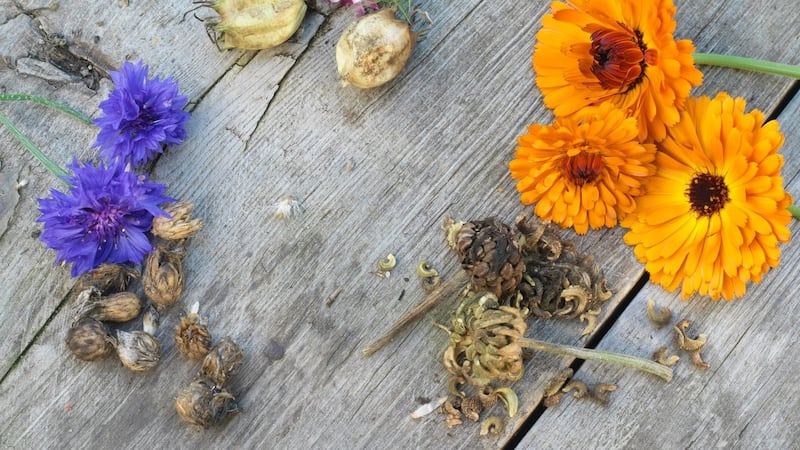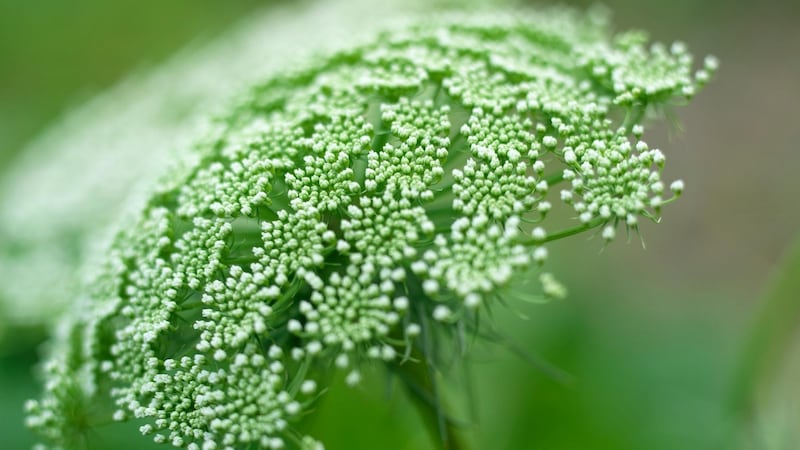Rework those summer pots: This month is an excellent time to give any tired-looking, drought-stricken summer containers a new lease of life so that they continue to flower abundantly right up until the first hard frosts.
Start by removing any dead or very sickly-looking plants and then check all remaining plants for any faded flowers or seed-heads, using a sharp secateurs or your fingers to nip these off.
Next, place the entire pot in a waterproof wheelbarrow/large bucket filled with liquid tomato feed/liquid seaweed feed diluted to the right concentration. Leave it for a few hours to thoroughly soak the compost. Then top-dress with some fresh compost and a sprinkle of slow-release organic fertilizer before filling any gaps with some of the most hardworking, floriferous stars of the late summer/autumn garden.
Examples of the latter include salvias, dahlias, sedums, rudbeckia and verbena, all of which are can be bought from good Irish garden centres at this time of year. Keep plants regularly deadheaded and liquid-fed (every week) and they’ll flower their socks off until late October.
Grow some winter food: August is an excellent time of the year to sow seed of winter salad crops and other leafy vegetables such as American landcress, lambs lettuce, hardy/winter lettuce varieties such as 'Winter Density', chard, chicory, winter purslane (claytonia), rocket, oriental mustards "Red Frills' and 'Green Wave', mibuna, mizuna, tatsoi, pak choi, choy sum and komatsuna.
You can also sow seed of radishes, kohl rabi, salad onions and spring cabbage. But don’t leave it too late as the sooner you sow, the better the opportunity the resulting young plants have of developing strong, healthy root systems before autumn kicks in and falling light levels/lowering temperatures start to radically slow down growth.
All of these winter crops will thrive in the protective environment of a polytunnel or glasshouse, or failing that, outdoors under a winter blanket of garden mesh or garden fleece. But it’s important to initially protect the freshly-sown seed from high temperatures which can sometimes inhibit germination or cause premature bolting.
So sow outdoors in the evening into seed trays or modules filled with a good-quality seed compost or into well-prepared seedbeds for transplanting into their final positions later in the year. Online organic Irish seed suppliers of the above include brownenvelopeseeds.com, greenvegetableseeds.com and theorganiccentre.ie
August wouldn't be August without the sight, smell and taste of homegrown tomatoes
Get the secateurs out: August is a busy time in the garden as regards pruning with many different kinds of plants clipped back or lightly sheared at this time of year to keep them in good shape and/or to encourage fresh growth and/or good flower/fruit production next year.
Examples include lavender as well as other shrubby Mediterranean heat-loving herbs such as thyme, rosemary, oregano and sage, (lightly shear away faded flowers and fresh new growth but avoid cutting into old wood), the ornamental climber known as wisteria (cut new whippy shoots back to 5-6 leaves), early summer flowering perennials such as geraniums and alchemilla, certain varieties of rambling and climbing roses (any that aren’t repeat-flowering), some types of early summer flowering shrubs such as philadelphus, weigela and laburnum, pus espalier and cordon-trained apple and pear trees (prune the latter in late August).
Tomato time: August wouldn't be August without the sight, smell and taste of homegrown tomatoes. But it's also the month when these divas of the kitchen garden/allotment are at their most demanding in terms of a careful watering, liquid feeding and pruning routine.
For best results, examine indeterminate/upright/cordon-type tomato plants every day to nip out any new side shoots and to continue to train the main stems onto individual bamboo canes or lengths of strong, taut garden twine tied vertically from the roof of the glasshouse/polytunnel and twined onto the plant.
Once a sufficient number of trusses (the clusters of fruit) have set, ‘stop’ your tomato plants by cutting off the growing point a couple of leaves above the uppermost ‘set’ truss to encourage the plant to put all its energy into the developing fruit rather than new growth.
As a rough rule, allow six to eight trusses if growing in the ground, four or five if growing in containers. Only water once the soil/compost shows clear signs of drying out (but never let it dry out completely), avoid wetting the foliage to help prevent disease and give the roots a potash-rich liquid-feed once a week.
Removing the leaves beneath the lowest fruit truss will help prevent disease. Dedicated tomatophiles should also make sure to visit this year's Totally Terrific Tomato Festival, which takes place in the National Botanic Gardens in Glasnevin from 18th-26th August (see botanicgardens.ie for details).

Harvest some seed: Many garden plants are beginning to produce ripe, viable seed at this time of year, which can be saved and stored for later use. Saving seed in this way is economical, nature-friendly and helps preserve biodiversity as well as being a whole lot of fun with the resulting plants often displaying very interesting or attractive traits surprisingly different from their parent plants.
At its simplest, it's a simple matter of heading out into the garden or allotment on a dry, bright, windless day with a handful of small paper bags or envelopes (to safely store the ripe seed) and a pen (to write the date harvested as well as the name, location and description of the plant). For more detailed information on how best to harvest, prepare and store the seed of different species, visit the following websites: theseedsite.co.uk and seedsavers.org.
Sow some flowers: Next summer may seem an awfully long way off but late August is an excellent time of the year to start sowing seed of many different kinds of flowering hardy annuals including cornflowers (Centaurea cyanus), annual scabious, Ammi majus and Ammi visnaga, Orlaya grandiflora, Californian poppies, Salvia viridis and honeywort (Cerinthe).

Early autumn sowing (as opposed to spring sowing) results in much larger, earlier-flowering, longer-flowering and more floriferous plants. Recommended suppliers include all good Irish garden centres as well as specialist online suppliers such as Galway-based seedaholic.com.
Sweet pea are the one exception when it comes to early autumn sowing of hardy flowering annuals; hold off sowing seed of these beautiful annual climbers until October/November.
To ensure the highest rate of success, make sure to choose healthy, non-flowering shoots
Turn that heap: With so much fresh green waste and grass clippings being added to them throughout the spring and summer months, our garden compost heaps really benefit from some tender loving care at this time of year. Along with heat (no worries there), they need a balanced mix of two-thirds carbon-rich material (dead leaves, shredded cardboard, wood ash, straw, chopped-up twigs, branches and even sawdust) to one-third nitrogen-rich organic matter (chopped up green garden waste, kitchen peelings, rotten fruit and weeds, but not the latter's seed-heads or any material from invasive perennial weeds such as bindweed, Japanese knotweed and horse-tail) added in 15cm layers. Traditional compost heaps also need plenty of oxygen to encourage aerobic rather than anaerobic breakdown (the latter is what makes heaps smelly), which is why it's so important to turn them every few weeks. Many gardeners also swear by the regular addition of a little human urine but I'll leave that part up to you.
Make new plants for free: August is the time to take semi-hardwood cuttings of many different kinds of plants including lavender, hydrangeas, artemisia, penstemon, salvia, rosemary, fuchsia, agastache, pelargoniums, buxus, seanothus, hebe, viburnum, holly, bay and thyme.

To ensure the highest rate of success, make sure to choose healthy, non-flowering shoots (10-15cm long) and cut them in the evening or early morning using a sharp clean secateurs or scissors, then place the cut material straight into a jar of water or a sealed ‘freezer’ bag to which you’ve added a splash of cold, clean water. Keep this out of direct bright sunlight/heat, and then prepare the cuttings as quickly as possible.
To do this, strip the lower leaves off each cutting leaving no more than three sets of leaves, then sink each cutting up to its waist in a good-quality seed compost to which you’ve added some horticultural grit. Water well and label (date, name of plant, origin), then gently cover the plant material with a transparent lid or an upturned freezer bag (puncture a few small holes in it) sealed around the upper edge of the pot with an elastic band.
Place the pot somewhere warm (a heated propagator is perfect) but not hot and not in direct sunshine. Gradually open and then remove the lid/bag once you see signs of growth. Once they’ve rooted (usually by next spring), your cuttings can then be transplanted into individual pots or into the ground.
Dates For Your Diary: Saturday 18th (from 2pm) and Sunday 19th August (from 3pm), 'Garden Vista', Chanel College, Coolock village, Dublin 5, a two-day flower show held by Dublin 5 Horticultural Society with extensive displays of roses, dahlias, cut-flowers, vegetables, fruit, baked goods and artwork; Sunday 19th August (from 11pm), Hunting Brook gardens, The Lamb Hill, Blessington, County Wicklow, 'Full Bloom', a celebration of the garden in full bloom with a talk on salvias by garden owner and salvia obsessive Jimi Blake at 12pm, a guided tour of the garden by Jimi with the focus on his favourite plants for August (2pm), a talk on growing/using cut-flowers from the garden by @theirishflowerfarmer Fionnuala Fallon (3.30pm) and specialist plant sales, see huntingbrook.com











